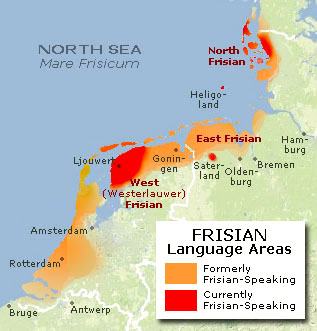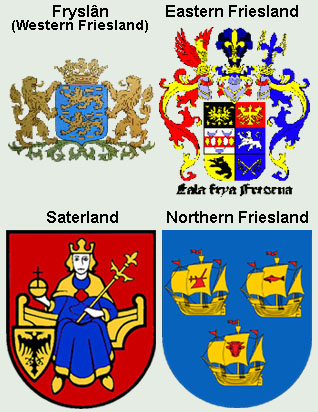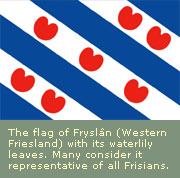|

Frisian
 Gysbert
Japicx (1603-1666),
Gysbert
Japicx (1603-1666),
pioneer in using and promoting
Frisian as a literature language |
Language information:
The Frisians may well be called “the North Sea People.” Most of their early history remains a mystery. However, their physical survival
under the onslaughts of the frequently stormy North Sea and their faithfulness
to their ethnicity as a long-time minority is generally regarded as nothing
short of remarkable. Their ancestors are widely considered associated with
the Bronze Age Elp Culture
(1800–800 BCE). Frisians used to inhabit the European Lowlands coast from just south
of what is today’s Netherlands-Belgian border to the mouth of River Elbe in
what
is
now
Northern
Germany. Even though their language and culture, technically speaking, became
extinct in most areas, they left marked imprints on the Dutch and Low Saxon
languages
and cultures that replaced them.
The traditional
Frisian area later came to be extended along  the west coast of the Jutish peninsula
to just north of today’s German-Danish border. Simply speaking, this extension
from western regions occurred in two stages: around 700 CE and around 1100 CE.
The Frisian dialect spoken by the first group of settlers survived and further
developed on the islands while
the mainland
and its tideflats islands came to be dominated by the Frisian dialect imported
by the second wave of immigrants. the west coast of the Jutish peninsula
to just north of today’s German-Danish border. Simply speaking, this extension
from western regions occurred in two stages: around 700 CE and around 1100 CE.
The Frisian dialect spoken by the first group of settlers survived and further
developed on the islands while
the mainland
and its tideflats islands came to be dominated by the Frisian dialect imported
by the second wave of immigrants.
This and relatively
little communication between
islanders and mainlanders account for marked
differences between the insular and continental dialects of North Frisian.
Within the
other,
previously
contiguous Frisian language area there used to be a dialect continuum. This once smooth continuum came to be disrupted when the area came
to
be
devided
up
into
enclaves
due
to
Dutch
and Saxon encroachment. Dialect islands now developed with little communication with each other, and dialectical divergence increased.
Surviving Frisian varieties are the following:
| · |
WEST FRISIAN ((Westerlauwersk) Frysk)* |
| |
· |
Standard Frisian (Standertfrysk) |
| |
· |
Clay Soil Frisian (Klaaifrysk) |
| |
· |
Woodlands Frisian (Wâldfrysk) |
| |
|
· North Woodlands Frisian (Noardhoeks) |
| |
· |
South Frisian (Súdhoeks) |
| |
· |
Southwest Frisian (Súdwesthoeksk) |
| |
· |
Schiermonnikoog Frisian (Skiermûntseagersk) |
| |
· |
Hindeloopen Frisian (Hynljippen) |
| |
· |
Terschelling (Skylge) Frisian |
| |
|
· East Terschelling Frisian (Aasters) |
| |
|
· West Terschelling Frisian (Schyllingers) |
| · |
EAST FRISIAN (mostly extinct) |
| |
· |
Sater Frisian (Seeltersk)* |
| · |
NORTH
FRISIAN |
| |
· |
Mainland North Frisian* |
| |
|
· Mooring/Bökingharde
Frisian (Böökinghiirderfrasch) |
| |
|
· Goesharde Frisian (Gooshiirderfreesch) |
| |
|
· South Goesharde Frisian (Sud-Gooshiirder) |
| |
|
· Central Goesharde Frisian (Middel-Gooshiirder) |
| |
|
· North Goesharde Frisian (Noard-Gooshiirder) |
| |
|
· Karrharde Frisian (Karrhiirderfreesch) |
| |
|
· Wiedingharde
Frisian (Wiringhiirderfreesk) |
| |
|
· Tideflats Islands (Halligen)
Frisian (Freesk) |
| |
· |
Island North Frisian |
| |
|
· Heligoland (Lunn) Frisian (Halunder)* |
| |
|
· Föhr-Amrum Frisian (Fering-Öömrang)* |
| |
|
· Föhr (Feer) Frisian (Fering) |
| |
|
· Amrum (Oomram) Frisian (Öömrang) |
| |
|
· Sylt (Söl) Frisian (Söl’ring)* |
___
* May be considered discrete languages |
Some of the varieties, especially those used in Germany, are endangered. Severely
threatened is the survival of Tideflats North Frisian.
Frisian has been
written since about the 8th century CE. Old Frisian was predominantly used for
religious and legal texts. The Middle Frisian period lasted until 1820, with
more linguistic and literary variety. East Frisian began fading away early, due
to Middle Saxon encroachment. What is now Eastern Friesland became predominantly
Low-Saxon-speaking. Today’s Low Saxon varieties of Eastern  Friesland, misleadingly referred to
as “East Frisian,” have noticeable Frisian substrata which make them a special branch among the
Northern Low Saxon dialects. This applies to the Low Saxon varieties in the Netherlands
province of Groningen as well. Friesland, misleadingly referred to
as “East Frisian,” have noticeable Frisian substrata which make them a special branch among the
Northern Low Saxon dialects. This applies to the Low Saxon varieties in the Netherlands
province of Groningen as well.
The only surviving
varieties of Eastern Frisian are those of Sater Frisian of the Saterland region
south
of
Eastern Friesland, where staunchly Roman Catholic Frisians formed an enclave
during the Christian Reformation.
These varieties
came to dominate among the local indigenous Westphalian-Low-Saxon-speaking farmers
as well.
It
is
quite
possible
that
the local Frisian varieties
absorbed
some indigenous Saxon features and that Sater
Frisian has Low Saxon
substrata.
What outside the
Netherlands is called “West Frisian” is called “Westerlauwer Frisian” in the Netherlands (Westerlauwersk Frysk in Frisian, and Westerlauwers Fries in Dutch). These are the Frisian varieties used west of the Lauwers river
in the province of Fryslân (formerly called Friesland in Dutch) and parts of the province of Groningen (West Frisian Grinslân, Low Saxon Grönnen). What is called West-Fries (“West Frisian”) in Dutch has come to denote a number of Dutch dialects on Frisian substrata
used in
the province of North Holland.
While these days
all surviving varieties of Frisian are officially recognized within the framework
of the European Languages Charter, the varieties used in Germany are struggling
to survive. West Frisian is doing relatively well due to a comparably large number
of speakers (ca. 350,000 native speakers) and fervent efforts on the part of
language activists and the provincial administrations. The language is used in
the mass
media and
in
schools, and there are printed and electronic publications, including modern
entertainment
material, in West Frisian. The language is used in
the mass
media and
in
schools, and there are printed and electronic publications, including modern
entertainment
material, in West Frisian.
Because of its relatively
sizeable speaker community and its relatively secure and prominent position,
West Frisian tends to be considered representative as simply “Frisian”, especially among Netherlanders,
including non-Frisians. It behooves everyone to bear in mind that Frisian of
the Netherlands is not the only type. Lately, inter-Frisian communication and
common
activities have been helping to propagate the notion of a more widespread and
diverse Frisian world, and East Frisians tend to be included in this as ethnic
Frisians despite the fact that most of them have lost their
ancestral
Frisian
language.
There are some Frisian-speaking,
mostly West-Frisian-speaking,
communities outside Europe, particularly in North America, Australia and New
Zealand, as well as in overseas parts of the Kingdom of the Netherlands.
The Frisian languages
are considered
the closest relatives of the Anglic languages (English and Scots), and some speak of an Anglo-Frisian branch among the West Germanic languages.
While the languages of the Angles and Saxons are routinely mentioned in connection
with the genesis of Old English (or Anglo-Saxon), Frisian is rarely mentioned
although it evidently participated in the process, apparently more so than did
the other two languages. One reason for what appear to be Frisian elements in
English
and scarcity of officially mentioned Frisian presence in medieval Britain might
be that Anglic, Saxon and Jutish colonists took with them across the Channel
Frisian-speaking women who raised their British-born children.
Gerhard Willers’s
remarks about Sater Frisian:
“When
I still lived in Cologne I learned Sater Frisian through self-study only with
the help of a Sater Frisian reading book for schools and a dictionary (Sater
Frisian-German), but my good knowledge of Northern Low Saxon helped me a lot
to learn it quickly.
I strongly believe that Sater Frisian has a Low Saxon (Westphalian) substrate.”
“Sater
Frisian is only spoken in the municipality of Saterland, which is situated
in the Northwest of the Landkreis (district) of Cloppenburg or on the other hand
in the Southeast of the town of Leer, Lower Saxony. The municipality of Saterland
consists of the villages Strukelje (Strücklingen), Roomelse (Ramsloh), Schäddel
(Scharrel) and Sedelsbierich (Sedelsberg). The estimated number of the speakers
of Saterfrisian is 2000. There are some slight differences with respect
to
vocabulary and pronunciation of Sater Frisian between the places Strücklingen,
Ramsloh and Scharrel. But this does not prevent mutual intelligibility of the
Saterland people when speaking Sater Frisian. But for the Low Saxon and German
speaking population of the neighbouring villages, Sater
Frisian is completely
unintelligible.”
“For
me the most striking features of Saterfrisian are its melodic sound,
(it has much more diphthongs and even some triphthongs than Low Saxon) and in
grammar the existence of two infinitives (like all other Frisian variants). Sater
Frisian
is a very old and conservative language, so it has preserved Frisian words that
are already extinct in other Frisian variantes, for example: Jool (English: wheel,
German: Rad) and it has even preserved Low Saxon words that are already extinct
in the present Low Saxon, for example: the German word Hühnerauge (corn on a toe) reads in modern
Low Saxon Höhneroog; and in Saterfrisian? Well, I admit, many people in Saterland
would say in Seeltersk Hanneoge. But there are also many people who say Liektouden, a cognate of Standard
German Leichdorn; and this is indeed a very, very old German word which is no
longer used in
Standard German of today, at least not in this area.”
“Well, dear Lowlanders and other readers of these lines, there
is really much more to tell you about this old and mysterious and melodious and
even thrilling language,
I assure you.”
Genealogy:
Indo-European > Germanic > West > Frisian
Historical Lowlands language contacts: Dutch, English, Low Saxon
Author: Reinhard
F. Hahnscots.php |

